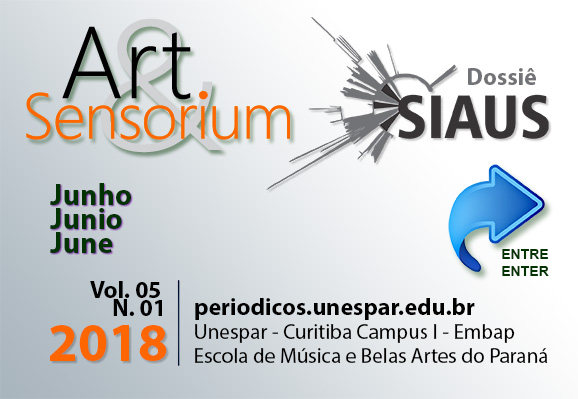O LEQUE E SUAS NARRATIVAS: PROJETOS E OBRAS EM VIDRO.
DOI:
https://doi.org/10.33871/23580437.2018.5.1.271-281Keywords:
Artes Visuais, Arte Contemporânea, Arte em Vidro, Leque, Cultura, Narrativas.Abstract
Este artigo apresenta o processo de criação e realização de um projeto que consistiu em desenvolver uma série de três leques em vidro, ressignificando a funcionalidade de tais objetos, numa proposta de criação artística em vidro. Questões como a opacidade, a transparência e a translucidez do vidro foram estudadas na relação obra – materialidade. As variáveis de material são indicadores relevantes. As relações advindas do alto teor simbólico do artefato "leque" , permitem a exploração de narrativas e de uma diversidade de manifestações culturais. Trata-se também de referência a um objeto de natureza e identidade femininas. Em sua história, apresenta a relação pendular entre "revelar" e "esconder" . Também há indícios de que já foi utilizado como uma "arma branca" , apresentando uma funcionalidade ao revés. A sutileza e a morte estão presentes. Quase opostas, geram para o leque, enquanto objeto de estudo, uma condição paradoxal. O corpo feminino ali está, atrás do leque. E nele se completa, se manifesta.
Downloads
Downloads
Published
Issue
Section
License
Copyright (c) 2022 International Interdisciplinary Journal of Visual Arts - Art&Sensorium

This work is licensed under a Creative Commons Attribution 3.0 Unported License.
Authors who publish with this journal agree to the following terms:- Authors retain copyright and grant the journal right of first publication with the work simultaneously licensed under a Creative Commons Attribution License that allows others to share the work with an acknowledgement of the work's authorship and initial publication in this journal.
- Authors are able to enter into separate, additional contractual arrangements for the non-exclusive distribution of the journal's published version of the work (e.g., post it to an institutional repository or publish it in a book), with an acknowledgement of its initial publication in this journal.
- Authors are permitted and encouraged to post their work online (e.g., in institutional repositories or on their website) prior to and during the submission process, as it can lead to productive exchanges, as well as earlier and greater citation of published work (See The Effect of Open Access).


